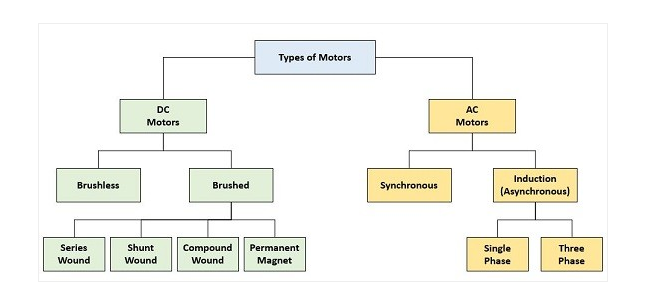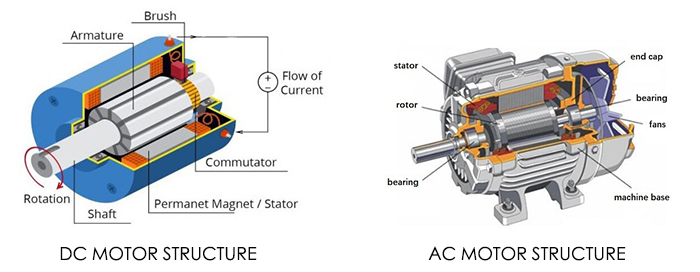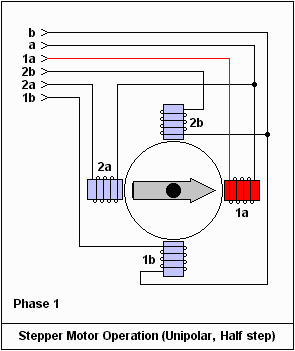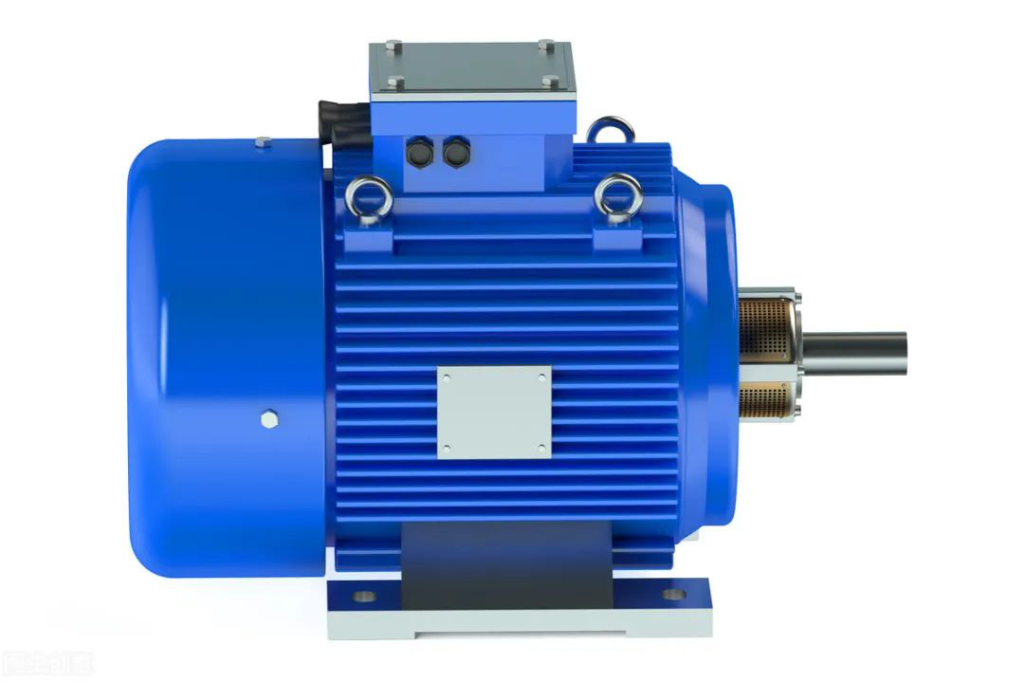1.DC Motor VS AC Motor

The differences between DC Motor and AC Motor
(1) Different power supply methods:
DC motor: use DC as the power supply;
AC motor: uses AC as the power supply.
(2) The structure is different:
The principle of the DC motor is relatively simple, but the structure is complex and not easy to maintain. The principle of the AC motor is complicated but the structure is relatively simple, and it is easier to maintain than the DC motor.
(3) The price is different:
The DC motor with the same power is higher than the AC motor, including the speed control device for controlling the speed, and the price of the DC speed control device is higher than that of the AC speed control device. Of course, the structure and maintenance are also very different.
(4) The performance is different:
Because the speed of the DC motor is stable and the speed control is precise, which cannot be achieved by the AC motor, the DC motor has to be used instead of the AC motor under the strict requirements of the speed. AC motor speed regulation is relatively complicated, but it is widely used because chemical plants use AC power.

2. Synchronous Motor VS Asynchronous Motor
Synchronous and asynchronous refers to whether the rotor speed and the stator rotating magnetic field speed are synchronous (same) or asynchronous (lag), so only AC can generate a rotating magnetic field, and only AC motors have the concept of synchronous and asynchronous.

1. The principle of synchronous motor
relies on “the magnetic field always goes along the shortest direction of the magnetic circuit” to realize the one-to-one correspondence between the rotor magnetic poles and the stator rotating magnetic field poles, and the rotor magnetic pole speed is the same as the rotating magnetic field speed.
Features: Whether the synchronous motor is used as a motor or a generator, its speed and AC frequency will be strictly unchanged. Synchronous motors have a constant speed and are not affected by load changes.
2. The principle of asynchronous motor
the movement is realized by induction, the stator rotates the magnetic field to cut the squirrel cage so that the squirrel cage generates an induced current, and the induced current is forced to make the rotor rotate. There must be a speed difference between the rotor speed and the stator rotating magnetic field speed to form a magnetic field cutting the squirrel cage and generating an induced current.

3. The specific difference between synchronous and asynchronous motors:
(1) Synchronous motors can generate reactive power and absorb it; asynchronous motors can only absorb reactive power.
(2) The speed of the synchronous motor is synchronized with the AC power frequency 50Hz power supply, that is, 2-pole motor 3000 rpm, 4-pole motor 1500 rpm, 6-pole motor 1000 rpm, etc. The speed of the asynchronous motor lags behind slightly, that is, 2880 rpm for 2 poles, 1440 rpm for 4 poles, 960 rpm for 6 poles, etc.
(3) The current of the synchronous motor is ahead of the voltage in phase, that is, the synchronous motor is a capacitive load. Synchronous motors can be used to improve the power factor of the power supply system.
4. Three-phase asynchronous motor (squirrel cage)

(1) Structure:
Rotor: squirrel cage
Stator: 3 windings
(2) Principle:
Three-phase asynchronous motor (Triple-phase Asynchronous Motor) is a kind of induction motor, which is connected to 380V three-phase AC current (phase difference 120 degrees) at the same time to form a rotating magnetic field, and the squirrel cage generates induced current, and then moves. The movement is realized by induction, the stator rotates the magnetic field to cut the squirrel cage so that the squirrel cage generates an induced current, and the induced current is forced to make the rotor rotate. There must be a speed difference between the rotor speed and the stator rotating magnetic field speed to form a magnetic field cutting the squirrel cage and generating an induced current.
(3) start:
Star-delta start, step-down start.
(4) Commutation:
Swap the wiring of any two connectors in the three phases of the stator.
(5) Speed regulation:
The speed regulation is difficult.
(6) Features:
Since the rotor and the stator rotating magnetic field of the three-phase asynchronous motor rotate in the same direction and at different speeds, there is a slip, so it is called a three-phase asynchronous motor. The rotor speed of the three-phase asynchronous motor is lower than that of the rotating magnetic field. The relative motion between the rotor winding and the magnetic field generates electromotive force and current and interacts with the magnetic field to generate electromagnetic torque to realize energy conversion.
Compared with single-phase asynchronous motors, three-phase asynchronous motors have better running performance and can save various materials. According to different rotor structures, three-phase asynchronous motors can be divided into cage type and wound type. The asynchronous motor with cage rotor has a simple structure, reliable operation, lightweight and low price, and has been widely used. Its main disadvantage is that it is difficult to adjust the speed.

3. Ordinary motor VS variable frequency motor
1. The difference between ordinary and variable frequency motors
First of all, ordinary motors cannot be used as variable frequency motors. Ordinary motors are designed according to constant frequency and constant voltage, and it is impossible to fully meet the requirements of frequency converter speed regulation, so they cannot be used as variable frequency motors.
(1) The influence of the frequency converter on the motor is mainly in the efficiency and temperature rise of the motor. The frequency converter can generate different levels of harmonic voltage and current during operation so that the motor operates under non-sinusoidal voltage and current, and the higher harmonics inside It will cause the stator copper loss, rotor copper loss, iron loss, and additional loss to increase. The most notable is the rotor copper loss. These losses will cause the motor to generate extra heat, reduce efficiency, and reduce the output power. The temperature rise of ordinary motors generally increases by 10%-20%.
(2) The insulation strength of the motor. The carrier frequency of the frequency converter ranges from several thousand to more than ten kilohertz, which makes the stator winding of the motor bear a high voltage rise rate, which is equivalent to applying a steep impulse voltage to the motor and making the inter-turn insulation of the motor withstand a relatively serious test.
(3) Harmonic electromagnetic noise and vibration. When an ordinary motor is powered by a frequency converter, the vibration, and noise caused by electromagnetic, mechanical, ventilation, and other factors will become more complicated. The harmonics contained in the variable frequency power supply and the inherent space harmonics of the electromagnetic part of the motor interfere with each other to form various electromagnetic excitation forces, thereby increasing the noise. Due to the wide operating frequency range of the motor and the wide range of rotational speed, it is difficult for the frequency of various electromagnetic force waves to avoid the natural vibration frequency of each structural part of the motor.
(4) Cooling problem at low speed. When the frequency of the power supply is low, the loss caused by the high-order harmonics in the power supply is large; secondly, when the speed of the variable motor decreases, the cooling air volume decreases proportionally to the cube of the speed, resulting in The heat of the motor cannot be dissipated, and the temperature rise increases sharply, making it difficult to achieve constant torque output.
2. How to distinguish between ordinary motors and variable frequency motors?
(1) Higher insulation level requirements
Generally, the insulation grade of the frequency conversion motor is F grade or higher, and the ground insulation and the insulation strength of the turns are strengthened, especially the ability of the insulation to withstand the impact voltage should be considered.
(2) The vibration and noise requirements of variable frequency motors are higher
The variable frequency motor should fully consider the rigidity of the motor components and the whole, and try to increase its natural frequency to avoid resonance with each force wave.
(3) The cooling method of the frequency conversion motor is different
The frequency conversion motor is generally cooled by forced ventilation, that is, the cooling fan of the main motor is driven by an independent motor.
(4) Different requirements for protection measures
Bearing insulation measures should be adopted for variable frequency motors with a capacity exceeding 160KW. The main reason is that it is easy to produce magnetic circuit asymmetry and axial current. When the currents generated by other high-frequency components work together, the axial current will increase greatly, resulting in bearing damage, so insulation measures are generally taken. For constant power variable frequency motors, when the speed exceeds 3000/min, special grease with high-temperature resistance should be used to compensate for the temperature rise of the bearing.
(5) The cooling system is different
The frequency conversion motor cooling fan is powered by an independent power supply to ensure continuous cooling capacity.
4. Motor selection procedure
The basic contents required for motor selection include the type of load driven, rated power, rated voltage, rated speed, and other conditions.
For production machinery with stable load and no special requirements for starting and braking, ordinary squirrel-cage asynchronous motors should be preferred, which are widely used in machinery, water pumps, fans, etc.

For production machinery that starts and brakes frequently and requires a large starting and braking torque, such as bridge cranes, mine hoists, air compressors, irreversible rolling mills, etc., a wound asynchronous motor should be used. Where there is no requirement for speed regulation, where constant speed is required or power factor improvement is required, synchronous motors should be used, such as medium and large-capacity water pumps, air compressors, elevators, mills, etc.
For production machinery that requires a speed range of more than 1:3 and requires continuous, stable, and smooth speed regulation, separately excited DC motors or squirrel-cage asynchronous motors or synchronous motors with frequency conversion speed regulation should be used, such as large precision machine tools and gantry planers. , rolling mill, elevator, etc.
For production machinery that requires large starting torque and soft mechanical characteristics, series or compound excitation DC motors are used, such as trams, electric locomotives, heavy cranes, etc.
Generally speaking, the motor can be roughly determined by providing the type of load driven, the rated power, the rated voltage, and the rated speed of the motor. But these basic parameters are not enough if the load requirements are to be met optimally. The parameters that need to be provided include frequency, working system, overload requirements, insulation level, protection level, the moment of inertia, load resistance moment curve, installation method, ambient temperature, altitude, outdoor requirements, etc., according to specific conditions.
5. Summary of Motor Fault Handling Experience
When the motor is running or malfunctioning, the four methods of seeing, listening, smelling and touching can be used to prevent and eliminate the fault in time to ensure the safe operation of the motor.
1. Look
Observe whether there is any abnormality during the operation of the motor, which is mainly manifested in the following situations.
1. When the stator winding is short-circuited, you may see smoke from the motor.
2. When the motor is seriously overloaded or running without phase, the speed will slow down and there will be a heavy “humming” sound.
3. The motor maintenance network is running normally, but when it stops suddenly, you will see sparks from the loose wiring; the fuse is blown or a part is stuck.
4. If the motor vibrates violently, it may be that the transmission device is stuck, the motor is not fixed properly, or the anchor bolts are loose.
5. If there is discoloration, burn marks, and smoke traces at the contact points and connections in the motor, it may indicate local overheating, poor contact at conductor connections, or burnt windings.
2. Listen
When the motor is running normally, it should emit a uniform and light “hum” sound, without noise or special sound. If there is too much noise, including electromagnetic noise, bearing noise, ventilation noise, mechanical friction sound, etc., it may be a precursor or phenomenon of failure.
1. For electromagnetic noise, if the motor makes a high and low, or heavy sound, there may be the following reasons:
(1) The air gap between the stator and the rotor is uneven. At this time, the sound fluctuates and the interval between high and low sounds remains unchanged. This is due to the wear of the bearings and the non-concentricity of the stator and the rotor.
(2) The three-phase current is unbalanced. This is due to misgrounding, short circuits, or poor contact with the three-phase windings. If the sound is dull, it means that the motor is seriously overloaded or running with a lack of phase.
(3) The iron core is loose. During the operation of the motor, the fixing bolts of the iron core are loosened due to vibration, resulting in the loosening of the silicon steel sheet of the iron core and making noise.
2. For bearing noise, should be monitored frequently during the operation of the motor. The monitoring method is: to put one end of the screwdriver against the bearing installation part, and the other end close to the ear, and you can hear the sound of the bearing running. If the bearing is in normal operation, the sound will be a continuous and small “rustling” sound, without fluctuating highs and lows and metal friction sounds.
3. Smell
Faults can also be judged and prevented by smelling the smell of the motor. Open the junction box and sniff. Check to see if there is a burnt smell. If you find a special smell of paint, it means that the internal temperature of the motor is too high; if you find a strong smell of burnt or burnt smell, it may be that the insulation layer has been broken down or the winding has been burned. If there is no smell, it is necessary to use a megohmmeter to measure that the insulation resistance between the winding and the casing is lower than 0.5 megabytes, and it must be dried. If the resistance is zero, it means it is damaged.
4. Touch
The cause of the fault can also be judged by touching the temperature of some parts of the motor. In order to ensure safety, the back of the hand should be used to touch the motor casing and the parts around the bearing. If the temperature is found to be abnormal, the reasons may be as follows.
1. Poor ventilation. For example, the fan falls off, the ventilation channel is blocked, etc.
2. Overload. As a result, the current is too large and the stator windings are overheated.
3. Turn-to-turn short circuit of the stator winding or unbalanced three-phase current.
4. Frequent starting or breaking.
5. If the temperature around the bearing is too high, it may be caused by bearing damage or lack of oil.


